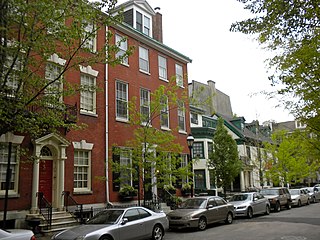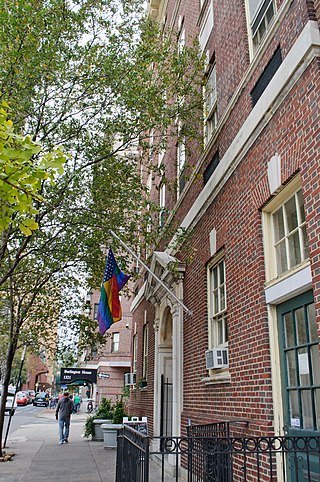
A gay village, also known as a gayborhood, is a geographical area with generally recognized boundaries that is inhabited or frequented by many lesbian, gay, bisexual, transgender, and queer (LGBT) people. Gay villages often contain a number of gay-oriented establishments, such as gay bars and pubs, nightclubs, bathhouses, restaurants, boutiques, and bookstores.

The LGBT community is a loosely defined grouping of lesbian, gay, bisexual, and transgender individuals united by a common culture and social movements. These communities generally celebrate pride, diversity, individuality, and sexuality. LGBT activists and sociologists see LGBT community-building as a counterweight to heterosexism, homophobia, biphobia, transphobia, sexualism, and conformist pressures that exist in the larger society. The term pride or sometimes gay pride expresses the LGBT community's identity and collective strength; pride parades provide both a prime example of the use and a demonstration of the general meaning of the term. The LGBT community is diverse in political affiliation. Not all people who are lesbian, gay, bisexual, or transgender consider themselves part of the LGBT community.

Washington Square West is a neighborhood in Center City, Philadelphia, Pennsylvania, United States. The neighborhood roughly corresponds to the area between 7th and Broad Streets and between Chestnut and South Streets, bordering on the Independence Mall tourist area directly northeast, Market East to the north, Old City and Society Hill to the East, Bella Vista directly south, Hawthorne to the southwest, and mid-town Philadelphia and Rittenhouse Square to the west. The area takes its name from Washington Square, a historic urban park in the northeastern corner of the neighborhood. In addition to being a desirable residential community, it is considered a hip, trendy neighborhood that offers a diverse array of shops, restaurants, and coffee houses. Washington Square West contains many gay-friendly establishments, especially in the gay village area of the neighborhood commonly known as the Gayborhood, which hosts annual events celebrating LGBT culture in Philadelphia, including OutFest.

LGBT culture is a culture shared by lesbian, gay, bisexual, transgender, and queer individuals. It is sometimes referred to as queer culture, while the term gay culture may be used to mean either "LGBT culture" or homosexual culture specifically.

LGBT pride is the promotion of the self-affirmation, dignity, equality, and increased visibility of lesbian, gay, bisexual, and transgender (LGBT) people as a social group. Pride, as opposed to shame and social stigma, is the predominant outlook that bolsters most LGBT rights movements. Pride has lent its name to LGBT-themed organizations, institutes, foundations, book titles, periodicals, a cable TV channel, and the Pride Library.

The William Way LGBT Community Center is a nonprofit organization serving the lesbian, gay, bisexual and transgender population of Philadelphia, Pennsylvania and nearby communities, located at 1315 Spruce Street in Philadelphia in the Gayborhood.

The lesbian, gay, bisexual and transgender (LGBT) community in San Francisco is one of the largest and most prominent LGBT communities in the United States, and is one of the most important in the history of American LGBT rights and activism alongside New York City. The city itself has been described as "the original 'gay-friendly city'". LGBT culture is also active within companies that are based in Silicon Valley, which is located within the southern San Francisco Bay Area.

New York City has been described as the gay capital of the world and the central node of the LGBTQ+ sociopolitical ecosystem, and is home to one of the world's largest LGBTQ populations and the most prominent. Brian Silverman, the author of Frommer's New York City from $90 a Day, wrote the city has "one of the world's largest, loudest, and most powerful LGBT communities", and "Gay and lesbian culture is as much a part of New York's basic identity as yellow cabs, high-rise buildings, and Broadway theatre". LGBT travel guide Queer in the World states, "The fabulosity of Gay New York is unrivaled on Earth, and queer culture seeps into every corner of its five boroughs". LGBT advocate and entertainer Madonna stated metaphorically, "Anyways, not only is New York City the best place in the world because of the queer people here. Let me tell you something, if you can make it here, then you must be queer."
Throughout Dallas–Fort Worth, there is a large lesbian, gay, bisexual, and transgender community. Since 2005, DFW has constituted one of the largest LGBT communities in Texas.
Chicago has long had a gay neighborhood. Beginning in the 1920s there was active homosexual nightlife in Towertown, adjacent to the Water Tower. Increasing rents forced gay-friendly establishments steadily northwards, moving through Old Town and Lincoln Park along Clark Street and on to Boys Town.

Gloria Casarez was an American civil rights leader and LGBT activist in Philadelphia. Casarez served as Philadelphia's first director of lesbian, gay, bisexual and transgender (LGBT) affairs. During her tenure as director, Philadelphia ranked as the number one city nationwide for LGBT equality. Casarez served as the executive director of Gay and Lesbian Latino AIDS Education Initiative (GALAEI) from 1999 to 2008.
Austin, Texas, has one of the most prominent and active LGBT populations in the United States. Austin was acclaimed by The Advocate in 2012 as part of its Gayest Cities in America, and was recognized by Travel and Leisure as one of America's Best Cities for Gay Travel. Much of Austin's gay nightlife scene is clustered around 4th Street. LGBT activism groups Atticus Circle and Equality Texas are headquartered in Austin.
The Pride Center at Equality Park is an LGBTQ+ community center in Wilton Manors, Florida, that serves Broward County, Palm Beach County, and Fort Lauderdale. The center provides information, news, and events that affect South Florida's LGBT community. Established in 1993, the center is headquartered within a 30,000 square feet (2,800 m2) building with meeting and office space for individuals, programs, services, and organizations. The goal of the center is to empower the LGBT communities in South Florida.
LGBT culture in St. Louis is characterized by a long history of progressive activism as well as racial divisions and the city/county divide. St. Louis city is relatively liberal with multiple gayborhoods and several LGBT organizations. In 2019, Realtor.com dubbed St. Louis the 8th most LGBT-friendly city. Due to hostile legislation at the state level, however, it has become common for LGBT residents to relocate to Illinois for better protections and healthcare access.

LGBT culture in Baltimore, Maryland is an important part of the culture of Baltimore, as well as being a focal point for the wider LGBT community in the Baltimore metropolitan area. Mount Vernon, known as Baltimore's gay village, is the central hub of the city's lesbian, gay, bisexual, and transgender communities.
The National LGBTQ Wall of Honor is a memorial wall in the Greenwich Village neighborhood of Manhattan in New York City, dedicated to LGBTQ "pioneers, trailblazers, and heroes". Located inside the Stonewall Inn, the wall is part of the Stonewall National Monument, the first U.S. National Monument dedicated to the country's LGBTQ rights and history. The first fifty nominees were announced in June 2019, and the wall was unveiled on June 27, 2019, as a part of Stonewall 50 – WorldPride NYC 2019 events. Five honorees will be added annually.
On April 25, 1965, the first of two historic sit-ins occurred at the popular Dewey's Restaurant in Philadelphia, Pennsylvania. It was one of the earliest demonstrations advocating for the LGBT community in United States history. Three unidentified teenagers and approximately 150 supporters walked into the Dewey's location at 219 South 17th Street, refusing to leave in the name of civil rights. This initial sit-in was in response to Dewey's recently implemented discriminatory policy claiming it would not serve “homosexuals,” “masculine women,” “feminine men,” nor “persons wearing nonconformist clothing.” Philadelphia police arrested the three teenagers, which led to further grass-roots action. Clark Polak, president of the local Janus Society, extended support to the protesters. Members of the Janus Society and other supporters circulated approximately 1500 flyers throughout the local area over the next five days. On May 2, 1965, protesters staged a second sit-in at Dewey's, although this time there were no arrests. Soon after the second sit-in, Dewey's Restaurant reversed their policy. The Dewey's sit-ins helped continue the path towards equal rights for many LGBT people in the United States.
^ Nickels, Thom Gay and Lesbian Philadelphia, Arcadia Publishing, 2002







